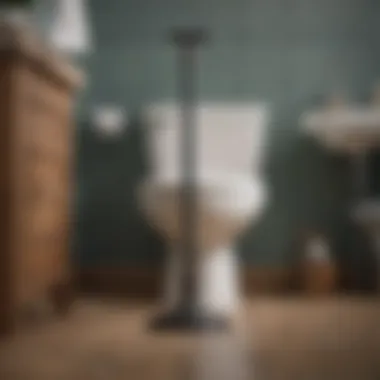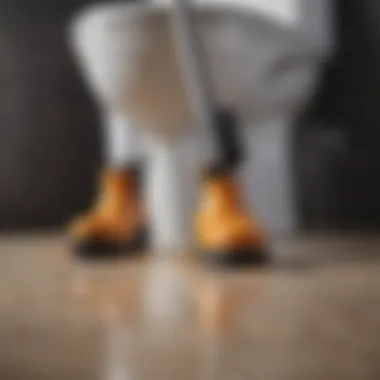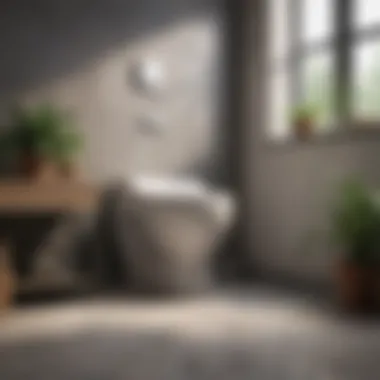Effective Strategies for Unclogging a Toilet


Intro
Toilets are an essential part of any home. When they clog, it can lead to stress and frustration. Understanding how to address this common issue is vital for homeowners. This article provides practical methods for unclogging a toilet using various tools and techniques. It also emphasizes preventative measures to maintain proper toilet function. With the right knowledge, anyone can handle toilet clogs effectively.
Understanding the Problem
Toilet clogs often arise from various causes. Commonly, excessive toilet paper or foreign objects can create blockages. The design of modern toilets can also contribute to clogging. Most toilets have a trapway, which can hold onto debris and cause a blockage. Recognizing the mechanics of your toilet can help in understanding how to resolve these issues.
Tools and Techniques for Unclogging
Basic Tools Needed
- Plunger: A standard toilet plunger is the first line of defense for clogs.
- Auger: A toilet auger, or snake, is useful for deeper blockages.
- Bucket: A bucket can help manage overflow or excess water.
Plunging Techniques
Proper plunging technique is crucial. Here is how to do it:
- Ensure the flange of the plunger seals over the drain.
- Use firm, consistent strokes to create suction.
- Repeat for a few minutes until the water starts to drain.
The key to effective plunging is maintaining a good seal with the flanges of the plunger.
Using an Auger
If the plunger does not work, consider using an auger. Here’s a quick guide:
- Insert the auger into the toilet drain.
- Push it gently until you feel resistance.
- Crank the handle to break up the clog.
Using an auger can often resolve deeper blockages that are unreachable by a plunger.
Chemical Solutions
While mechanical methods are effective, sometimes chemical solutions can be beneficial. Drain cleaners can dissolve organic materials causing clogs. However, caution is necessary with chemicals. Always follow the manufacturer’s instructions for safe use. Some chemicals may harm your plumbing if used excessively.
Preventative Measures
It is better to prevent clogs than to deal with them after they happen. Here are some strategies:
- Limit the use of toilet paper: Consider using less at a time.
- Avoid flushing non-degradable items: Items like wipes, cotton balls, and hygiene products belong in the trash.
- Regular maintenance: Regularly check your toilet for any signs of wear or issues.
Epilogue
Unclogging a toilet is a skill that everyone can master with the right tools and knowledge. Understanding both the mechanical functions of a toilet and the methods for unclogging can save time and prevent stress in the future. With proper maintenance and attention, toilet clogs can often be avoided, keeping plumbing systems running smoothly.
Understanding Toilet Clogs
Understanding toilet clogs is fundamental for any homeowner. Addressing this common household issue requires a thorough comprehension of how toilets function and why clogs occur. Being able to identify causes and implement solutions can save time, prevent damage, and enhance the overall efficiency of your plumbing system.
Common Causes of Clogs
Numerous factors contribute to toilet clogs. Recognizing these causes can help in preventing future blockages. Here are some of the most significant reasons:


- Excessive Toilet Paper: Flushing large amounts of toilet paper in one go can overwhelm the plumbing system, causing a blockage.
- Foreign Objects: Items like toys, feminine hygiene products, or outdated medical waste can easily get lodged in the toilet bowl.
- Flushing Non-biodegradable Materials: Items such as wipes labeled as "flushable" may not break down easily. This practice leads to a quick build-up and subsequent clogging.
- Hard Water Deposits: Over time, minerals in hard water can accumulate in pipes, narrowing the passages and making clogs more likely.
By being aware of these common culprits, the homeowner can make informed decisions regarding toilet usage.
How Toilets Work
To fully grasp how to manage clogs, it is necessary to understand the mechanics of toilet operation. Toilets utilize a simple yet effective design that combines gravity and water pressure.
- The Tank: After each flush, the tank refills with water. This water is what pushes waste away through the pipes.
- The Flush Valve: When the toilet handle is pressed, the flush valve opens, releasing water from the tank into the bowl. The sudden rush of water guides waste into the drainage system.
- The S Trap: This design feature is crucial. It creates a natural barrier that prevents sewer gases from entering the bathroom. However, if waste gets stuck in the trap, it can lead to a clog.
A clear understanding of how the toilet works can help in preventing misuse and subsequently reduce the risk of toilet clogs.
Initial Steps for Unclogging
Before diving into the methods of unclogging a toilet, understanding the initial steps is key. These steps dress the foundation for an effective unclogging process. By assessing the situation first, you gauge the severity of the clog. This helps to choose the right method and tools. Observations made at this stage can save time and effort.
Assessing the Situation
Assessing the situation involves examining the toilet and its surroundings. Check for visible signs of a blockage. Look for water standing above the toilet rim. This can indicate a serious blockage that needs immediate attention. If water is just slow to drain, there might be a minor obstruction.
Consider what caused the clog. Was it too much toilet paper, some foreign object, or perhaps a buildup? Knowing the cause guides what strategy to use. Clear the area around the toilet to avoid accidents. Ensure there's enough space for tools and movement. This safety measure prevents further mess.
Gathering Necessary Tools
Having the right tools on hand ensures a smoother unclogging process. Without proper equipment, even simple clogs can become frustrating.
Plunger
The plunger is a fundamental tool for unclogging toilets. Its main purpose is to create pressure that helps dislodge blockages. The key characteristic of a plunger is its rubber suction cup that fits snugly over the toilet drain. This is what separates it as a widely favored choice. A unique feature is the flange design, which allows for a better seal compared to standard cups. This makes plunging more efficient. However, plungers require some technique to use effectively. Without proper plunging, it may not work as well.
Toilet Auger
The toilet auger, or snake, is an essential tool for dealing with deeper clogs. It consists of a flexible metal cable with a coiled end that can reach obstructions further down the toilet. A major characteristic is its length, which enables it to tackle clogs that a plunger cannot reach. This makes it a beneficial choice for serious obstructions. The unique feature of the toilet auger is its ability to break through tough clogs, such as those made from solid objects. However, it requires care during use. If used improperly, it may scratch or damage the toilet's interior.
Rubber Gloves
Rubber gloves are a crucial part of the unclogging process. Their main function is to provide hand protection from germs and mess while working. The key characteristic of rubber gloves is their waterproof material, which keeps hands clean. They are a must-have choice for anyone attempting to unclog a toilet. A unique feature is their flexibility, allowing users to grip tools better. However, they can feel uncomfortable for some. It’s important to have a pair that fits well to minimize this discomfort.
The initial steps can greatly influence the success of your unclogging efforts. Take the time to assess and gather your tools to ensure efficiency.
Mechanical Methods for Relief
Mechanical methods for unclogging toilets encompass the use of physical tools and manual techniques to resolve clogs directly. This approach is critical because it can often provide immediate relief without the need for potentially harmful chemicals. By addressing the blockage directly, users can minimize further issues and maintain the integrity of plumbing systems. Knowing and applying the different mechanical strategies available ensures efficiency and effectiveness in unclogging tasks.
Using a Plunger
Proper Plunging Technique
The proper plunging technique is vital for effective unclogging. It involves forming a tight seal around the toilet’s drain, enabling forceful pressure to freely move the blockage. The key characteristic of this technique is its straightforward nature, making it accessible for nearly anyone to try. This method is often favored due to its simplicity and reliance solely on physical effort rather than additional resources. A unique feature of proper plunging is the rhythmic motion employed, alternating between pushing downwards and pulling upwards to create suction. The advantages are manifold: it is eco-friendly and does not involve residue left in the plumbing, making it a safe first option for unclogging.
Choosing the Right Plunger
Choosing the correct plunger is essential for successful unclogging. A key characteristic of an effective plunger is the shape of its cup; a flange plunger is ideal for toilets due to its design enhancing efficiency through suction. This choice is beneficial as it is specifically constructed for toilet use, unlike standard plungers intended for sinks. The unique feature of the flange plunger's design allows it to navigate the toilet’s unique drain shape more effectively. Despite its advantages, users need to ensure they have the right type, as using an unsuitable plunger can lead to ineffective unclogging efforts.


Introducing a Toilet Auger
Selecting the Right Size
Selecting the right size of toilet auger is crucial in addressing tougher clogs. The main characteristic of a toilet auger is its length and flexibility, allowing it to navigate through pipes. This tool is particularly useful because it can reach blockages that a plunger cannot. The unique feature of a properly sized auger facilitates efficient maneuvering in a toilet's curve. For optimal performance, the auger should be long enough to reach the clog but not overly cumbersome to use. Choosing too small can mean insufficient reach, while too large can prove unwieldy, resulting in ineffective usage.
Technique for Effective Use
Utilizing the toilet auger effectively involves a specific technique. To use it, one must insert the auger into the toilet drain, then crank the handle while pushing it forward. This action helps to pierce through or break up stubborn blockages. A key characteristic of effective use is maintaining a steady pressure while managing the snake’s maneuver. This technique is beneficial as it provides deeper penetration into the plumbing system, potentially resolving problems that simpler methods might miss. However, it does come with disadvantages; excessive force or incorrect technique can inadvertently damage the toilet’s internal components, leading to more problems. Therefore, knowledge of the tool and patience is essential.
Chemical Solutions
Chemical solutions play a critical role in addressing toilet clogs. They provide homeowners with options beyond mechanical methods. The use of chemicals can sometimes yield quick results, especially in stubborn clogs that resist physical removal techniques. However, it is essential to approach chemical solutions with caution, as not all substances are safe for all plumbing systems.
Commercial Drain Cleaners
Commercial drain cleaners are widely available and typically contain strong chemicals designed to break down clogs. These products often promise rapid results, making them appealing for those looking for a quick fix. However, many of these cleaners are caustic and can damage pipes if not used correctly. It's crucial to carefully follow the instructions provided.
Considerations for using commercial cleaners include:
- Compatibility: Ensure that the cleaner is suitable for your specific toilet and plumbing type.
- Safety: Always use gloves and ensure proper ventilation to avoid inhaling harmful fumes.
- Effectiveness: Some brands may be more effective than others, requiring research or recommendations before purchasing.
Homemade Remedies
Using homemade remedies can be a gentler and eco-friendlier approach to unclogging toilets. Below, two popular options are discussed in detail.
Baking Soda and Vinegar
Baking soda and vinegar are often recommended as a natural unclogging solution. When combined, they create a reaction that can help to break up clogs, particularly those caused by organic materials.
Key characteristics of this method include:
- Natural Ingredients: Both substances are non-toxic and safe for most plumbing.
- Popular Choice: Many homeowners prefer this method due to its cost-effectiveness and safety.
The unique feature of this remedy lies in the reaction between the baking soda and vinegar, which can help to dislodge debris in the pipes. The advantages include being readily available in most households, while the downside is that it may not work for all types of clogs, especially severe ones.
Dish Soap and Hot Water
Dish soap combined with hot water serves as another effective homemade remedy. This method utilizes the lubricating properties of the soap to help break down blockage.
Key characteristics include:
- Simplicity: Easy to implement as both ingredients are usually found in the kitchen.
- Gentle on Pipes: Unlike harsher chemicals, this method is less likely to cause damage to plumbing.
The unique feature of using dish soap is its ability to reduce friction in pipes, allowing a potential clog to break apart more easily. Advantages include its ease of use and low cost, while the disadvantage may be its limited effectiveness on large, solid blockages.
Effective strategy for unclogging toilets often blends practical actions with responsive methods.
Utilizing the right chemical solution can make the difference between simply delaying a plumbing issue or resolving it effectively.
Preventative Measures


Preventative measures are essential in maintaining the functionality of a toilet and reducing the likelihood of clogs. Understanding these strategies can save homeowners time, effort, and money in the long run. Proper toilet maintenance not only keeps everything flowing smoothly but can also extend the lifespan of the plumbing system.
Routine Maintenance
Routine maintenance involves regularly checking and cleaning the toilet and its components. This can help identify potential issues before they escalate into bigger problems. Regular cleaning minimizes buildup of materials that can lead to clogs, such as limescale, soap scum, and mineral deposits.
Another important aspect of routine maintenance is ensuring the toilet’s internal parts are functioning properly. This includes checking the flapper, fill valve, and flush mechanism. Replacing worn or broken components promptly helps avoid unexpected failures.
Establishing a cleaning schedule can be beneficial. For example, cleaning the toilet at least once a week can prevent stains and buildup that may cause blockages.
Identifying Problematic Items
Identifying what can be flushed down the toilet is crucial. Many items, although seemingly harmless, can cause clogs if flushed. It is essential to educate everyone in the household regarding proper flushing guidelines.
Flushing Guidelines
Flushing guidelines refer to the rules regarding items suitable for flushing. The primary purpose of these guidelines is to ensure that only waste and toilet paper are disposed of through the toilet. Anything else can lead to blockages and complications further down the plumbing system.
These guidelines are beneficial because they reduce the number of clogs significantly. By adhering to them, the risk of needing to conduct mechanical or chemical unclogging methods decreases. A unique feature of these guidelines is their simplicity. Following them is easy and requires little effort, making them an effective preventative measure.
Regular Inspections
Regular inspections involve periodic checks of the toilet and connected plumbing. Conducting these inspections helps detect minor issues before they develop into serious problems. Inspections should focus on looking for leaks, ensuring there are no obstructions in the tank, and checking for proper water levels.
The benefit of regular inspections is that they provide reassurance about the toilet's condition. Catching and correcting issues early can prevent costly repairs down the line. A distinctive feature of regular inspections is their proactive nature. Unlike reactive measures, which address problems once they occur, regular inspections prevent issues from occurring in the first place.
When to Call a Professional
Understanding when to seek help from a plumbing professional is crucial in maintaining an efficient home. There are instances where attempts to resolve a clog may only exacerbate the problem. Homeowners should consider contacting a licensed plumber when faced with persistent or severe toilet clogs as well as when underlying plumbing issues raise their heads. The analysis of warning signs and thorough evaluation of the situation can guide this decision.
Recognizing Warning Signs
Recognizing the signs that indicate a need for professional assessment is essential. Homeowners may find the task overwhelming when clogs return repeatedly. Such persistent problems can indicate deeper problems. Additionally, slow-draining water can suggest a buildup that is not easily resolved with household tools. Unusual sounds or abnormal behaviors from the toilet when flushed may also be warning signs. These signs suggest that it is time to consult a professional.
Evaluating the Situation
Severe Clogs
Severe clogs often create an urgent situation. A key characteristic of severe clogs is their resistance to simple mechanical or chemical methods. This type of clog can blockage the toilet and cause water to back up. When this occurs, escalation is often necessary. It is beneficial to understand its significance in this narrative, as it can be a sign of deeper issues within the plumbing system. A unique feature of severe clogs is their ability to disrupt daily life. The longer they persist, the more costly repairs may become.
Underlying Plumbing Issues
Underlying plumbing issues require careful consideration. Their key characteristic often includes recurrent problems that typical unclogging methods do not address. Identifying these issues early is advantageous for preventing further damage and costly repairs later. A unique feature of underlying plumbing problems includes their potential to link to various sources, such as tree roots or pipe damage. Addressing them quickly can save both money and inconvenience, ensuring that your plumbing operates without recurring issues. Understanding these factors can help homeowners decide whether to enlist professional assistance.
Culmination and Summary
In the realm of household maintenance, addressing toilet clogs is a crucial aspect that can significantly impact daily life. This article has explored various effective strategies for unclogging toilets, offering a well-rounded understanding of both mechanical and chemical solutions. An effective unclogging approach necessitates familiarity with the common causes of clogs, the tools available, and preventive measures to reduce the frequency of such issues.
Key Takeaways
- Understanding Causes: Recognizing the common culprits behind toilet clogs, such as excessive toilet paper or foreign objects, is essential. This helps in tackling the problem more efficiently when it arises.
- Proper Tools: An effective unclogging job demands the right tools, including a plunger, toilet auger, and rubber gloves. Each tool serves a unique purpose and knowing when to use each can make a difference in unclogging efforts.
- Mechanical vs. Chemical: Using a combination of mechanical methods and chemical solutions can provide a comprehensive strategy. Chemical drain cleaners can be useful, but it is essential to follow directions and consider their environmental and plumbing effects.
- Preventative Steps: Regular maintenance and proper flushing guidelines can prevent many clog issues from occurring. Homeowners should stay proactive in managing what goes into the toilet to avoid significant blockages.
- Professional Help: Recognizing when to reach out to plumbing professionals is equally important. There are situations where severe clogs or underlying plumbing issues require expert evaluation and intervention.
Final Thoughts
The knowledge gained from this article provides a valuable toolkit for homeowners facing toilet clogs. Understanding the underlying problems and implementing effective strategies not only enhances plumbing functionality but also contributes to a more stress-free living environment. Toilet clogs are common, but with the right approach and preparation, they need not disrupt daily routines. The ability to manage such an issue effectively reflects a homeowner's commitment to maintaining their home, ensuring that they can enjoy their space without unexpected inconveniences.
"Being prepared with the right tools and knowledge equips homeowners to tackle toilet clogs smoothly and prevent future issues."
By integrating these strategies and maintaining vigilance, toilets can remain functional and efficient, allowing for a more comfortable and orderly home experience.



